20th Fighter Group
Early Squadron History -- World War I
The 55th Aero Squadron (later 467th) was organized at Kelly Field, Texas on 9 August, 1917. The 77th Aero Squadron was organized on 20 Feb, 1918, the 79th Aero Squadron two days later on 22 Feb, 1918, and the 78th Aero Squadron on 28 Feb, 1918. The 55th was demobilized on 16 March, 1919, the 77th on 18 Nov, 1919, and the 78th and 79th on 15 November, 1919.
The parent unit assignment, and type of equipment, during this period is not adequately recorded in the unit histories.
It All Started With Balloons
The 20th Fighter Group traced its lineage to the 18 October 1917 authorization of the 20th Balloon Group as an inactive element of the Department of the Army Air Arm. The group was redesignated as the 20th Pursuit Group in May, 1929. It was activated at Mather Field, California on 15 November 1930, and consisted of the 71 st Service Squadron (the administrative and support element of the group) and two flying squadrons.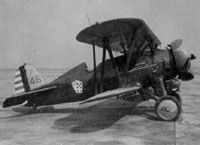
Comprising the flying element of the 20th Pursuit Group, the 55th Pursuit Squadron (attached) and 77th Pursuit Squadron (assigned) flew Boeing P-12s. The 78th Pursuit Squadron, with its P-12s, joined the 20th Pursuit Group on 1 April 1931, and the 79th Pursuit Squadron joined on 1 April, 1933.. The group's P-12, single-seat, biplane fighters featured two .30 caliber machine guns, an open cockpit, a 500 horse power Pratt and Whitney engine, and a top speed of 180 miles per hour.
Upon activation, the group welcomed the arrival of the first of many famous airmen to grace its ranks. Major Clarence L. Tinker, its first commander, led the group until 13 October 1932. Major Tinker, part Osage Indian, gained fame as Major General Tinker, World War II commander of the Seventh Air Force in the Pacific Theater. Tinker Air Force Base, Oklahoma, was named in his honor a year after his death, in 1942.
To Barksdale By Sea
The Group remained at Mather Field for a little less than two years until 15 October 1932. On that date an advance party of more than 200 officers, enlisted men, and their dependents, under the command of Captain Thomas Boland, sailed from San Francisco aboard the USS Grant. They traveled through the Panama Canal and debarked at New Orleans, Louisiana, on 30 October, 1932. On the following day, they arrived at Barksdale Field, Louisiana. The 55th Pursuit Squadron's P-12s arrived at Barksdale on the same day. The 77th Pursuit Squadron followed suit on 15 November 1932.
Major Millard F. Harmon, first commander of the newly opened Barksdale Field, took over command of the 20th Pursuit Group on its arrival at Barksdale. Just prior to its transfer to Barksdale, the group was assigned, along with the 3rd Attack Group, to the 3rd Attack Wing in June 1932. The 3rd Attack Wing and Group operated out of Fort Crockett, Texas.
The 20th had hardly settled at Barksdale Field when, on 7 November 1932, it took part in its first tactical pursuit exercise from the new base. En route to Fort Crockett, its 27 P-12s engaged in mock aerial warfare over Beaumont, Texas. By February 1933 when Barksdale Field was formally dedicated, the group's training program was in full operation. Its aerial training mission focused on the development of procedures and techniques for engaging enemy aircraft and provided for the protection of vital industrial centers, airdromes, and bombardment aircraft.
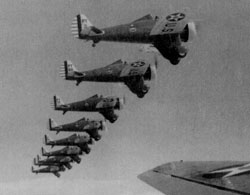 In October 1934, the group (by then three flying squadrons strong) made its first aircraft transition -- from the P-12 to the Boeing P-26 Peashooter. This open cockpit monoplane had a 600 horsepower engine and a top speed of 253 miles per hour. Like the P-12, it possessed two .30 caliber machine guns. Unlike its predecessor, it also featured wing-mounted bomb racks.
In October 1934, the group (by then three flying squadrons strong) made its first aircraft transition -- from the P-12 to the Boeing P-26 Peashooter. This open cockpit monoplane had a 600 horsepower engine and a top speed of 253 miles per hour. Like the P-12, it possessed two .30 caliber machine guns. Unlike its predecessor, it also featured wing-mounted bomb racks.
In February 1935, the 20th Pursuit Group was joined at Barksdale by the 3rd Attack Wing and 3rd Attack Group. Joint operations by the two combat groups were highlighted in 1937 by their participation in two aerial demonstrations, the first on behalf of the Command and General Staff School at Fort Leavenworth, Kansas, and the second during the American Legion Convention in New York. These demonstrations illustrated the effectiveness of newly developed pursuit and attack tactics and the significant firepower unleashed by A-17 and P-26 aircraft.
First Closed Cockpit Fighter
The 20th Pursuit Group acquired its first aircraft with a closed cockpit, the Curtiss P-36 Mohawk, in September 1938. The P-36 had a 1,050 horse power engine, and a top speed of 303 miles per hour. It could carry up to 400 pounds of bombs on its undercarriage.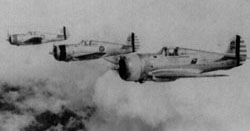
On 15 November 1939 the 20th moved to Moffett Field, California, stayed there less than one year, and moved again on 9 September 1940 to Hamilton Field, also in California .At Hamilton the group changed aircraft once again, this time to the Curtiss P-40 Warhawk. This was the top of the line pre-World War 11 pursuit fighter. It had a range of 750 miles, a top speed of 343 miles per hour, and six .50 caliber machine guns in the wings.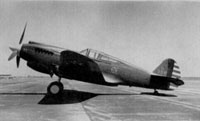 Several events in 1941 marked the group's assignment at Hamilton Field. Deployed flights spent the first part of1941at Muroc Lake, California, and Esler Field, Louisiana, conducting maneuvers. Also in January of 1941 the group gained Lieutenant Colonel Ira C. Eaker as its commander. Colonel (later Lieutenant General) Eaker remained with the group until September 1941. In October 1941, the group split into its component squadrons and deployed to various locations on the east coast, with group headquarters temporarily established at Morris Field, North Carolina. In December 1941, the 20th reassembled at Hamilton Field, California. Two days later the Japanese attacked Pearl Harbor, Hawaii.
Several events in 1941 marked the group's assignment at Hamilton Field. Deployed flights spent the first part of1941at Muroc Lake, California, and Esler Field, Louisiana, conducting maneuvers. Also in January of 1941 the group gained Lieutenant Colonel Ira C. Eaker as its commander. Colonel (later Lieutenant General) Eaker remained with the group until September 1941. In October 1941, the group split into its component squadrons and deployed to various locations on the east coast, with group headquarters temporarily established at Morris Field, North Carolina. In December 1941, the 20th reassembled at Hamilton Field, California. Two days later the Japanese attacked Pearl Harbor, Hawaii.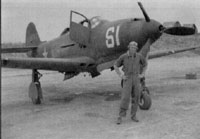 The 20th Pursuit Group made several station moves following the United States' declaration of war on Japan. From Hamilton Field it moved to Wilmington, North Carolina, to Morris Field, North Carolina, and to Paine Field, Washington - all in the latter part of 1942. While at Wilmington, the group exchanged its P-40s for P-39 Airacobras. In January 1943 the group moved to March Field, California, where it acquired its P-38 Lightning aircraft.
The 20th Pursuit Group made several station moves following the United States' declaration of war on Japan. From Hamilton Field it moved to Wilmington, North Carolina, to Morris Field, North Carolina, and to Paine Field, Washington - all in the latter part of 1942. While at Wilmington, the group exchanged its P-40s for P-39 Airacobras. In January 1943 the group moved to March Field, California, where it acquired its P-38 Lightning aircraft.
To Europe in "Luxury" on the Queen Elizabeth
Eight months later, on 11 August 1943, the personnel of the 20th departed California aboard three trains and arrived at Camp Miles Standish, Massachusetts, five days later. From this European staging area, the members of the 20th embarked on the HMS Queen Elizabeth and departed for the United Kingdom on 20 August 1943. If the members of the 20th had expected a typical Queen Elizabeth pleasure cruise,they were sorely disappointed. The ship had been refitted to accommodate over l9,000 men. Staterooms designed for two or three people had 20 to 30 bunks double and triple stacked for officers and enlisted men. In addition to these conditions, enlisted personnel also served shifts of 24 hours on deck, followed by 24 hours below deck. This doubled the number of personnel the cramped quarters could accommodate.
Due to its high speed, the HMS Queen Elizabeth traveled unescorted, despite the ever-present threat posed by German submarines. The five day trip across the Atlantic was reported as uneventful, except for long chow lines (two meals per day) and frequent boat drills. On 25 August 1943, HMS Queen Elizabeth dropped anchor and the men of the 20th disembarked at the Firth of Clyde. From there they were transported to the docks at Greenock, Scotland, and then on, by train, to their new home, King's Cliffe Airfield, North Hamptonshire, England. Fortune smiled on the 55th Pursuit Squadron at this time. Due to space restrictions they had to be stationed at RAF Wittering, about five miles from the rest of the group. The facilities at RAF Wittering were much superior to those at King's Cliffe. The 55th Squadron joined the rest of the group at King's Cliffe in April 1944.
King's Cliffe
Arriving at King's Cliffe, the group faced the prospect of operating from one of the poorest airfields in England. The buildings were old and inadequate and airfield facilities were close to non-existent. The only thing in abundance was poor weather and mud. Overcoming the initial shock of these conditions the group soon settled in and got on with the serious job of flying. The group was assigned to the Eighth Air Force throughout the war.
Prior to the 20th's arrival in theater, the Republic P-47 Thunderbolt served as the primary U.S. fighter aircraft in Europe. This aircraft was a formidable match for the German Luftwaffe (Air Force) fighters in air-to-air combat but lacked one important feature -- range.
Without sufficient range, the conduct of daytime bomber escort missions, first into Europe and then Germany itself, proved nearly impossible. That problem was perhaps best illustrated on 14 October 1943 when 60 (20 percent) of 293 unescorted bombers, dispatched against the ball bearing works in Schweinfurt, failed to return from the mission.
The P-38 Era Begins
With the arrival of the Lockheed P-38 in Europe, the long range escort mission of the Eighth Air Force began in earnest. Initially, due to a lack of available aircraft, the 20th conducted operations as an attached component of the 55th Fighter Group. Full group operations for the 20th commenced in late December 1943 when the group became fully equipped with P-38s.
One of the early highlights of the group's World War II exploits entailed the escort of a bombing mission into the Bordeaux area of France on 31 December 1943. This 1,300 mile, round trip, constituted the longest fighter escort mission to date. That distance, in fact, stretched the P-38s beyond their operational limits, forcing 17 of 31 aircraft to land at other bases due to insufficient fuel.
Lightning Limitations
Despite its advantages of range and speed over its German contemporaries, the P-38 suffered limitations which resulted in less than a break even rate in enemy aircraft downed versus 20th aircraft lost. Within a 90-day span, from 31 December 1943 to 31 March 1944 the operational ledger disclosed 52 German aircraft destroyed while the 20th's losses amounted to 54 pilots. By the end of the P-38 era in July 1944, the 20th's kill rate improved slightly. The group logged 84 pilots lost versus 89 German aircraft destroyed in the air and 31 destroyed on the ground.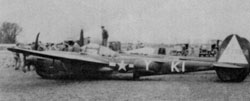 The P-38 was ill-equipped to deal with the extreme cold and high moisture conditions that prevailed at the operating altitudes of 20,000 to 33,000 feet over Northern Europe. A high number of group casualties resulted from engine failure at altitude. Thrown rods, engine explosions and unexpected power reduction during flight were all fatal flaws that the Axis aircraft exploited. The P-38, though equal to any German fighter at altitudes below 15, 000 feet, was no more than an even match in the best of conditions above that altitude.
The P-38 was ill-equipped to deal with the extreme cold and high moisture conditions that prevailed at the operating altitudes of 20,000 to 33,000 feet over Northern Europe. A high number of group casualties resulted from engine failure at altitude. Thrown rods, engine explosions and unexpected power reduction during flight were all fatal flaws that the Axis aircraft exploited. The P-38, though equal to any German fighter at altitudes below 15, 000 feet, was no more than an even match in the best of conditions above that altitude.
Despite the shortcomings of its aircraft, the 20th earned a healthy reputation based on its escort of successful bombing raids and its secondary mission of ground strafing. From the outset of its World War 11 operations, the 20th mission concentrated on escorting medium and heavy bombers to targets on the continent. It retained this primary mission throughout the war. Its escort missions completed, however, the group began to routinely strafe targets of opportunity while in route back to England. Pilots of the 20th focused their strafing attacks on railways and railroad cars. That preference soon earned them the title of "Loco Boys."
Ground Attack
In addition to its escort mission, the group furnished light bomber sorties. Between April and August 1944, pilots of the 20th Pursuit Group machine-gunned, dive-bombed, skip-bombed, and high-level-bombed German airfields, trains, barges, flak positions, gun emplacements, barracks, radio stations, and other targets throughout France, Belgium, and Germany. Early in that period, on 8 April 1944, the group earned a Distinguished Unit Citation for "extraordinary heroism, determination, and esprit de corps in action against the enemy." During attacks against two German airfields near Salzwedel, Germany, the group destroyed or damaged 43 enemy aircraft on the ground and three in the air. Group pilots then deployed over a broad front, sweeping the area westward on withdrawal. During that sweep, German fighters made a rear attack on the P-38 formation, destroying four of the group's number. In counter-attack, the 20th brought down three ME-109s and an FW-190 and dispersed their remaining force. The 20th air crews contnued their withdrawal west, and resumed their attacks on ground-targets of opportunity. Such was the ferocity of its attacks that day that the 20th Group recorded the destruction of 50 aircraft, 300 soldiers, 18 locomotives, 50 railway freight and oil tank cars, 30 oil tanks comprising three oil storage dumps, four high tension towers, two hangars, an electrical power house, six factories, one railroad station, 16 flak towers and gun positions, and two bridges.
The invasion of Normandy in early June 1944 featured 20th Pursuit Group daylight escort operations in support of Allied fleet movements. The P-38 was specifically chosen for the task due to its distinctive shape (dual-boom fuselage) and the ease with which fleet anti-aircraft gunners could distinguish it from enemy aircraft.
In July 1944, the P-38 era for the 20th came to an end. On 19 July, Lieutenant Colonel Cy Wilson, the group commander, led 49 Lightnings on a bomber escort mission into Southern Germany. The next day two squadrons of P-38s operated with one squadron of P-51s. The group flew its final P-38 combat mission on 21 July.
Transition to the P-51 (in Less a Week)
By 22 July 1944, the 20th had completely transitioned to the new North American P-51 Mustang. Lieutenant Colonel Wilson equated the P-38 to flying an 'airborne ice wagon,' when compared to a P-51. With their extended range and horsepower, this aircraft helped to sweep the last remnants of the Nazi Luftwaffe from the air. Indeed, from mid-1944, many missions were flown unopposed by Axis aircraft.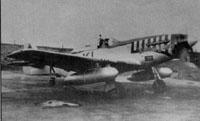 During the first month of P-51 operations, pilots of the 20th Pursuit Group demonstrated the increased air superiority of the Mustang by destroying 70 enemy aircraft. Their own losses numbered only 14 over the same period -- a far better kill-to-loss ratio than they had achieved with the P-38. The increased range of the P-51 enabled group pilots to extend their coverage of European operations by two to three hours flying time. Standard flying time for a P-38 ran approximately four hours. Missions of six or seven hours were not uncommon for the P-51.
During the first month of P-51 operations, pilots of the 20th Pursuit Group demonstrated the increased air superiority of the Mustang by destroying 70 enemy aircraft. Their own losses numbered only 14 over the same period -- a far better kill-to-loss ratio than they had achieved with the P-38. The increased range of the P-51 enabled group pilots to extend their coverage of European operations by two to three hours flying time. Standard flying time for a P-38 ran approximately four hours. Missions of six or seven hours were not uncommon for the P-51.
By November 1944, Allied air superiority had been so firmly established that the Luftwaffe attempted only two more full-scale interdiction missions against Allied bombers before the end of the war. On 2 November 1944, a German force of about 250 fighter aircraft intercepted 1,121 Eighth Air Force bombers and their fighter escort en route to the synthetic oil plants in Merseburg, Germany. In the ferocious air battle that followed, Eighth Air Force fighters destroyed 148 German planes, more than half the attacking force. Aircrews of the 20th Group contributed to the elimination of 33 enemy aircraft on that day. Lieutenant Colonel Robert P. Montgomery, led the 20th assault, destroyed three aircraft himself and was awarded the Distinguished Service Cross for his performance.
Bomber escort missions by the 20th Pursuit Group for the remaining eight weeks of 1944 met little German resistance. Weather conditions, mostly fog, limited the group's participation in the Battle of the Bulge. Nevertheless, Eighth Air Force (including the 20th Group) bombing and ground strafing of German road and railway lines of communication effectively strangled the enemy to death, and by 10 January the German army had begun its retreat to the Rhine.
The Luftwaffe's Last Push
Germany launched her final major air defense operation on 19 January 1945. This last full-scale attack against allied bombers lasted approximately 20 minutes. In those 20 minutes, over the German homeland, aircraft of the Eighth Air Force downed a total of 121 out of 2l4 attacking aircraft without the single loss of a fighter aircraft. Only nine B-17s,two percent of the total force,were lost.
The late introduction of Luftwaffe jet aircraft, far superior to the P-51 mainstay of the Allied fighter force in both speed and high altitude performance, came too late to alter the course of the air struggle over Europe. The ME-262 twin jet and ME-163 single rocket engine aircraft, first appeared in small numbers at the end of 1944. Though not a great threat in air-to air combat, (they lacked maneuverability), these aircraft proved almost impossible to stop when they attacked the heavy bombers.
The balance of the war featured little German resistance to Allied air power. Bombers of the Eighth Air Force saturated the German homeland almost at will. Strafing attacks by Allied fighters, including the 20th, paralyzed German communications, transportation, and airfields. During February 1945, pilots of the 20th Pursuit Group expended approximately 165,500 rounds of ammunition, more than 16 percent of its wartime total expenditures The 20th led all Eighth Air Force fighter groups in the destruction of enemy aircraft during that month.
In the last month of the war, aircrews of the 20th downed their first ME-262s. On 10 April 1945, during airfield attacks around Potsdam and Brandenburg, 20th pilots destroyed five ME-262s in individual encounters, while the group as a whole eliminated a total of 55 German fighters (mostly on the ground) without a single loss to its own numbers.
28 Aces
At the end of World War II, air aces (pilots who destroyed five or more enemy aircraft) of the 20th Pursuit Group numbered 28. The 77th Pursuit Squadron claimed group bragging rights with 10 aces, including the top three. Captain Ernest C. Fiebeikorn and Captain Charles H. Cole each had 11 total victories. Captain Fiebelkorn is generally acknowledged as the top 20th ace because his victories included nine in the air and only two aircraft destroyed on the ground. Captain Coles' total included five air victories and six on the ground. Captain James M. Morris missed out on sharing top honors with a victory total of 10 2/3, seven and one-third in the air and three and one-third on the ground. The 55th followed close behind the 77th with nine aces -- the 79th had five and the Headquarters section claimed four.
On the opposite end of the spectrum, the 20th lost 73 pilots to the Germans during the war, with a further 11 killed during training flights. The 20th also counted 56 of their number inhabiting Nazi prisoner-of-war camps during the war. Ten others bailed out in Axis territory, but evaded capture and eventually returned to Allied lines.
Following the war, the 20th Pursuit Group returned to the United States for inactivation at Camp Kilmer, New Jersey on 18 October 1945. It became activated again on 29 July 1946 at Biggs Field, Texas. In October 1946, the group relocated to Shaw Field, South Carolina, where it was assigned under the 20th Fighter Wing on 15 August 1947.